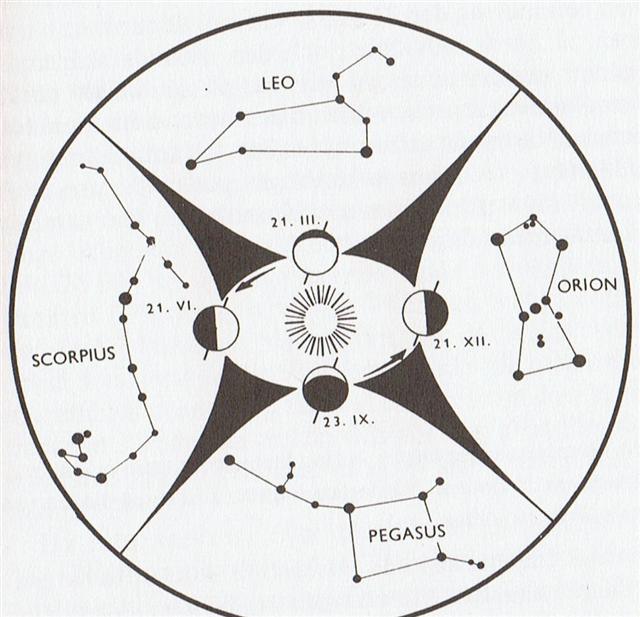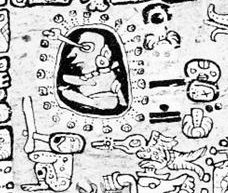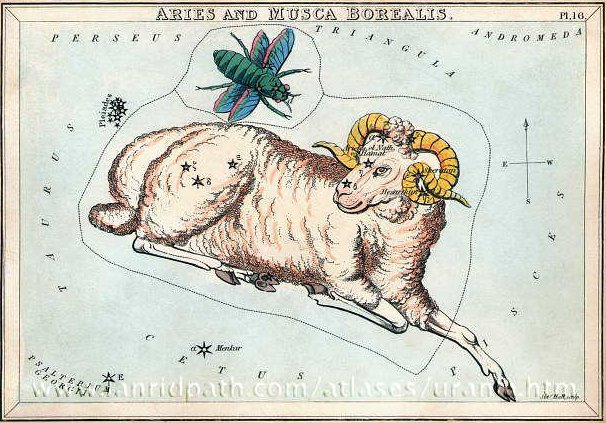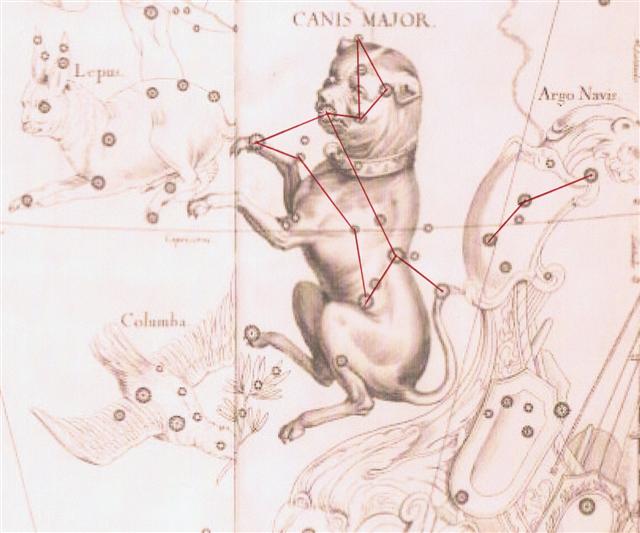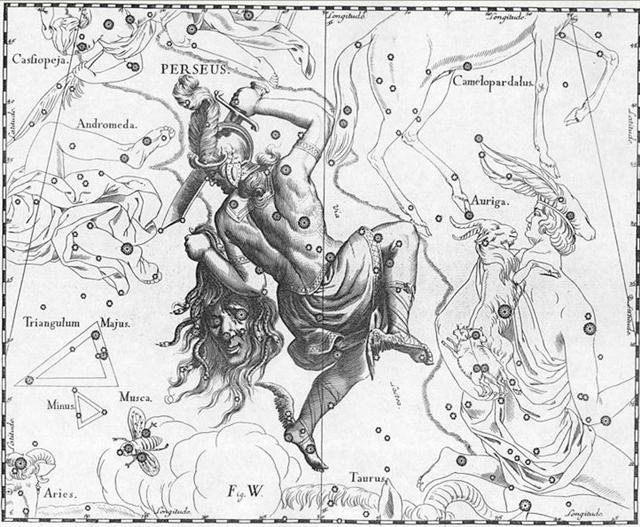We should remember how in the night sky the constellations are visualizing where the Sun is not. For instance is our experience of Leo that these stars are visible in autumn and not in spring:
However, south of the equator, as on Easter Island, the pictures in the night sky were in full agreement with the seasons, although needing some adjustment for the effects of the precession since the ancient times when the constellations were put in their places. For instance would once upon a time the hot summer Lion had been where Orion is today. In the picture above the rotation of the precession is going withershins. When Hamal at the back of the rising head of Ku was at 0h, and from there led his flock of 10 stars marking the ecliptic path of the Sun, Hamal could not have been seen because the intense light from the Sun would have made such observations impossible.
... Anc. Slav., kuti or kowati, a smith. Lith., kujis, a hammer; kauti, to fight ... ... 'By striking the anvil,' said Ogotemmêli, 'they get back from the earth some of the life-force they gave it. Their blows recover it.' But blows on the iron must be dealt by day. The smith's work is day labour, no doubt because the smithy fire, being a fragment of the sun, could not shine at night. That is why it is forbidden, not only for smiths but for everybody, to strike blows on iron or stone or earth in the night-time. No blow of hammer or tap of pestle should be heard, whether loud or soft, in the silent hours. To strike blows at night would destroy the effect of the blows struck by day. It would mean the rejection of all that had been gained, so that the smith would lose whatever he had recovered during the day of the life-force of which he formerly divested himself ... ... There was noise at night at Marioro, it was Hina beating tapa in the dark for the god Tangaroa, and the noise of her mallet was annoying that god, he could endure it no longer. He said to Pani, 'Oh Pani, is that noise the beating of tapa?' and Pani answered, 'It is Hina tutu po beating fine tapa.' Then Tangaroa said, 'You go to her and tell her to stop, the harbour of the god is noisy.' Pani therefore went to Hina's place and said to her, 'Stop it, or the harbour of the god will be noisy.' But Hina replied, 'I will not stop, I will beat out white tapa here as a wrapping for the gods Tangaroa, 'Oro, Moe, Ruanu'u, Tu, Tongahiti, Tau utu, Te Meharo, and Punua the burst of thunder'. So Pani returned and told the god that Hina would not stop. 'Then go to her again', said Tangaroa, 'and make her stop. The harbour of the god is noisy!' So Pani went again, and he went a third time also, but with no result. Then Pani too became furious with Hina, and he seized her mallet and beat her on the head. She died, but her spirit flew up into the sky, and she remained forever in the moon, beating white tapa. All may see her there. From that time on she was known as Hina nui aiai i te marama, Great-Hina-beating-in-the-Moon ... ... Like the sun, chiefs of the highest tabus - those who are called 'gods', 'fire', 'heat', and 'raging blazes' - cannot be gazed directly upon without injury. The lowly commoner prostrates before them face to the ground, the position assumed by victims on the platforms of human sacrifice. Such a one is called makawela, 'burnt eyes' ... But only around 16 nights later would Hamal have returned again into view at the horizon in the early morning east, although this would never happen close to the Full Moon because the nakshatra observations had to wait for half a year from the Sun.
At the time of rongorongo Hamal rose together with the Sun 30 days after 0h (and 4 days after Polaris):
Assuming we should use - when reading this part of the text - the time frame of the Romans at least up until 'March 25 (the Julian equinox), then Hamal (at Gb7-28, where 72 * 8 = 24 * 24) would have coincided with 'March 24 = day 83 + 365 = 448 (= 64 weeks) counted from the beginning of the previous year. Possibly we have here a reason for number 368, a number which seems to turn up more than by chance in the rongorongo texts. In Roman times 368 days counted from 0h in the previous year would have pointed at the ancient time of the Bull when Hamal had reached FEBRUARY 15 (46) - where 46 = 368 / 8. And 438 (Gb7-28) = 6 * 73 = 365 + 73. And 209 (Gb7-28) = 11 * 19 (= one more * Sun). 411 (= 46 + 365) - 73 = 338 = 13 * 26 = 365 - 27 (the precessional depth down to Roman times). 46 = 73 - 27. At the time of the Bull the sky would here have begun to grow lighter, this we can imagine in Ga7-29, whereas in Gb7-27 there was a kai glyph:
Earlier I thought it meant there was a season with much to eat before Hamal. However, there is another explanation, viz. that Metoro's kai at this type of glyph was short for kaiga = Land (the womb of Mother Earth) in contrast to the Sky vault.
... They were Ranginui, the Sky Father, and Papatuanuku, the Earth Mother, both sealed together in a close embrace. Crushed between the weight of their bodies were their many children, whose oppression deepened. They yearned to be free; they fought their parents and each other to break loose. Tuumatauenga, virile god of war, thrust and shouted; Tangaroa of the oceans whirled and surged; Tawhirirangimaatea, Haumiatiketike and Rongomatane, of wild foods and cultivated crops, tried their best but were not successful; and Ruamoko, god of earthquakes, yet to be born, struggled in the confinement of his mother's womb ... Of them all, Taane Mahuta, the god of the forests, was the most determined; he set his sturdy feet upon his father's chest, and braced his upper back and shoulders against the bosom of his mother. He pushed; and they parted. So the world, as the Maori understand it, came into being ... My interpretation is thus that we here should use the time frame of the Bull for identifying the stars and the time frame at the time of the Romans for finding out the calendar days. In a way it therefore becomes rather irrelevant to discuss whether the observer should be located south of the equator or in the north. However, at the time of Gregory XIII the star η Arietis (between her eyes) would have shifted ahead from the Julian equinox ('March 25) to °April 17 (107), i.e. with 107 - 84 = 23 precessional days. (365 - 23 = 18 * 19 = 342 = 6 * 57.)
Counting 107 days not from °January 1 but from 0h would have pointed at °July 6 where the Full Moon should have reached Aludra (η Canis Majoris) - viz. at the last glyph on side a of the tablet:
Ga8-26 was glyph 229 and at the time of the Bull the Sun would here have been 229 days after 0h. There were *111 (η Canis Majoris) - *31 (η Arietis) = 80 days from the '3rd eye' of Aries to the 'tip of the tail' of the Great Dog:
For the record: Assuming we should count 16 nights ahead from the heliacal days, in order to find out where for instance Hamal could become visible again, we will find a sign of bending over (moai) reversed. This was 20 days from Gb7-24:
|
|||||||||||||||||||||||||||||||||||||||||||||||||||||||||||||||||||||||||||||||||||||||||||||||||||||||||||||||||||||||||||||||||||||||||||||||||||||||||||||||||||||||||||||||||||||||||||||||||||||||||||||||||||||
